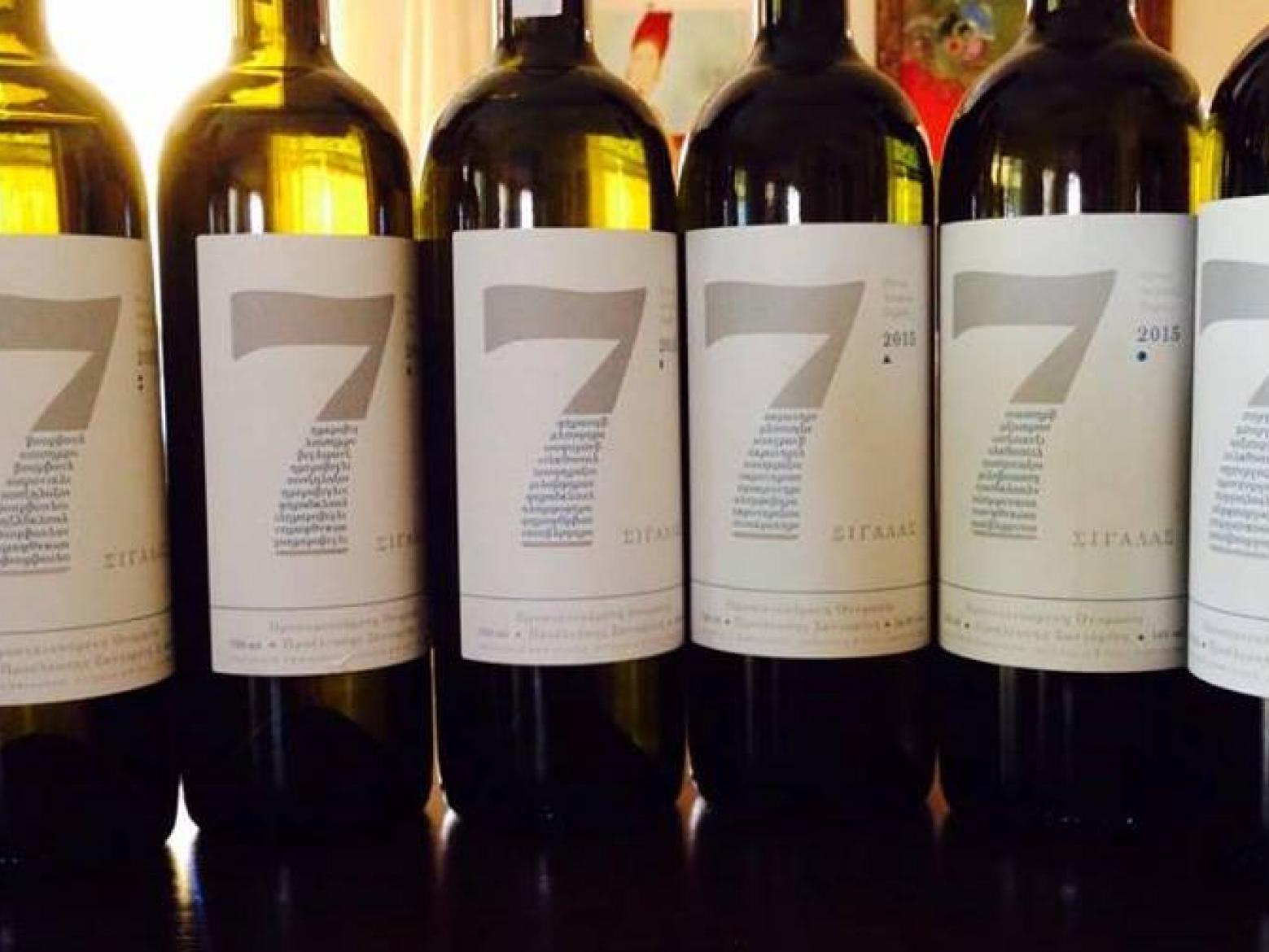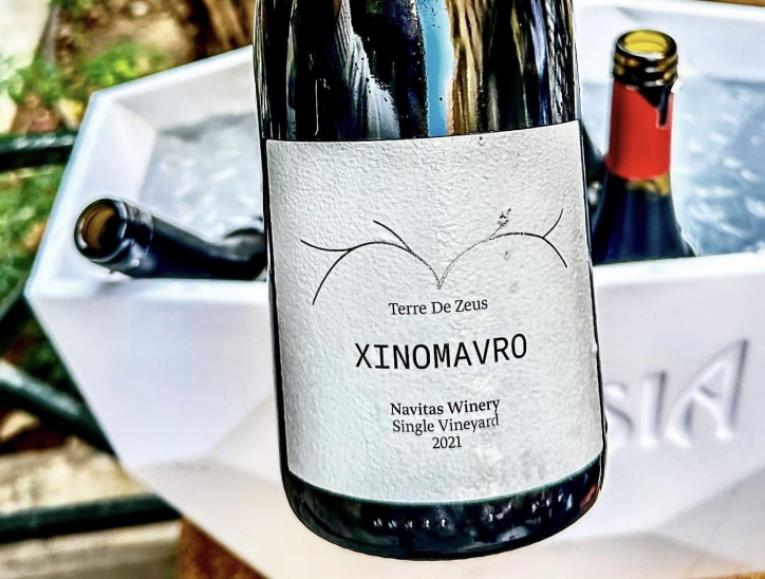7 villages: A Sigalas Journey
For quite some time now I was aware of Paris Sigalas’ (Sigalas Estate) plans to further explore Santorini’s terroir. And this was confirmed to me during my recent visit there with ''Taste and Wine'' ΤV show. During the shootings Sigalas showed us the small stainless steel tanks that he is using for his microvinifications with the grapes sourced from 7 different villages. Later on together with the rest of the team we were the first to taste the just bottled 7 villages, no label at that time.
Seven is not only a mathematical symbol for an ex mathematician like Sigalas but also a number with almost a symbolic meaning for Ancient Greece. The wonders of the world, the wise men, a tragedy by Aeschylus, it is all about 7...
Scientifically speaking, the soil in Santorini has a unique uniformity, that cannot be found elsewhere in Greece (see Kourakou, Santorini p 118). In Santorini we find in an even way pumice and black lava stones over a bedrock of limestone and schist.This signifies that different interpretations of the island's terroir should be credited to the other factors that affect the style of the resultant wine like aspect, slope, altitude and climate. Winemaking can be considered as well.
After a month or so from the show I was delighted to receive from Sigalas Estate a full set of wines packed in what I have to admit very ordinary box for wines that retail around 200 Euro (precise cost is 175). I proceeded in blind tasting the wines and then checked my initial assessment at the winery. The scores presented herein are actually the average of both assessments.
Such an exciting adventure indeed that could have been more fascinating if some initial thoughts were shared in a small booklet. That missing booklet could potentially explain the basic characteristics of the villages and what to expect (at least in theory). This I reckon would engage more tasters or consumers in the terroir game. Well, this was a good reason for a chance to discuss with the Sigalas' oenologist Eleni Voskidi who reverted with every detail as possible and a promise that the next vintage will be more complete in everything.
The wines were tasted with Coravin all at once and the tasting notes follow. Sigalas suggests to open all the wines simultaneously, Ι am more into enjoying them as everyone wishes, not finding necessary opening all of them at the same time.
1. Megalochori 15.4%
Typically the warmest mesoclimate (together with Vourvoulos) with southern exposure, lowland that enjoys good air circulation giving good quality healthy grapes. Single vineyard in 2015 it will become a blend of two sites in 2016.
Expected style: full bodied with high level of ripeness and good ageing potential. Confirmed by the tasting
Ripe nose, oxidative and very concentrated with honey, marzipan, buttery notes and minerality present. Big wine with maybe too sweet fruit, bright acidity and clean finish. Reminds me of a Nykteri style with no oak. 91
2. Vourvoulos 14.4%
Typically a rather warm mesoclimate with northeast exposure that moderates the effect. Most of the vineyards are low in altitude while the presence of a mountain just above protects from the winds. A terroir not very much expressed beyond Vassaltis winery. Grapes are sourced from various sites.
Expected style: Finesse with tannins, backward and phenolic according to oenologist (warm climate high level of ripeness with cooling effect). Style confirmed in the tasting.
Tight nose with shy intensity needing time to open up. Lots of stone fruit and herbal aromas. Structured on the palate with just sweet fruit and a phenolic touch. Youthful. 91+
3. Imerovigli 14.5%
Typically high in altitude (200-300m), open to north winds with northeastern exposure. Experiences lower temperature and harvest typically starts 7-10 days later. Grapes are sourced from three sites.
Expected style fresh, elegant and floral, austere. Confirmed in the tasting.
Elegant style maybe not so structured with apples, minerals and citrus fruit. Fresher with reasonable finish but lacking overall excitement. 89+
4.Fira 14.3%
Typically there is not uniformity with some sites lying low (here it is located the vineyard for the Sigalas 7), experiences good air circulation and good sun exposure whereas the grapes are later ripening compared to Oia and Vourvoulos. 2016 vintage will be a blend of sites higher in altitude on the same zone with Pyrgos.
Expected style: ?
Although very close to Imerovigli proved to be very different with creme brulee, orange marmalade and honey. Interesting white pepper character on the palate but overall broad with overt sweet fruit. 88
5. Akrotiri 15.1%
Typically low in altitude and unprotected from sea breeze located in the southern part of Santorini with south-southeastern-southwestern exposure. Grapes are sourced from various sites. Earlier ripening.
Expected style: salty, elegant and tight with some phenolics. Confirmed in the tasting.
Τight at first needs time to open up. Quite mineral with sweet fruit yet possesses firm tannins. Big and creamy with long finish. 92+
6. Oia 13.5%
Typically lying in the northern part of the island. Unprotected to all kind of winds; north winds straight from the sea and southern that come stronger because of the mountains. Mostly lowland and early ripening village. Grapes are sourced from various sites.
Expected style: ?
Classic Santorini with character and tension. Some bitterness on the finish with razor sharp acidity. 88
7. Pyrgos 13.8%
Typically not a uniform village. Blend of sites from the central part with southern exposure and at altitude close to Imerovigli (200-300m). Late ripening zone in general.
Expected style: Taut, mineral and elegant. Confirmed
Ripe and mineral nose with apricots and exotic fruit with underlined stony minerality. Medium full bodied, very salty with bright acidity. Intense and taut, textbook Santorini. 91
Checking the numbers, acidities were higher in Oia and Akrotiri, followed by Vourvoulos, while the lowest were in Megalochori (saw that coming) and Fira.
Small conclusion and I am open to a constructive discussion as I am a firm believer of the evolution of terroirs in Greece. First, it seems that styles can be grouped under big and rich for Megalochori and perhaps Fira and more elegant for the rest (Vourvoulos, Imerovigli, Akrotiri, Oia, Pyrgos). Salty may be a good descriptor for Akrotiri and structured for Vourvoulos and Pyrgos. Finally I found wines with more personality in Megalochori, Akrotiri, Pyrgos and Vourvoulos and I am looking forward for more...




